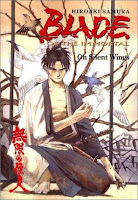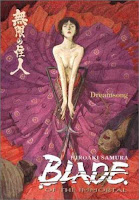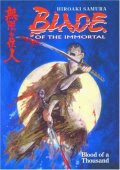 Creator: Hiroaki Samura
Creator: Hiroaki Samura
U.S. publisher: Dark Horse
ISBN: 9781569714126
Released: February 1999
Original run: 1994-ongoing (Afternoon)
Awards: Eisner Award, Japan Media Arts Award
I have been reading (though unfortunately not reviewing) a lot of manga recently and can easily say that Blade of the Immortal remains one of my absolute favorite series. I like the story, love the characters, and continue to be impressed by Hiroaki Samura’s artwork. On Silent Wings is the fourth trade collection in the series. The story picks up shortly after where the previous volume, Dreamsong, left it—containing the short arc “Rin’s Bane” and the beginning of the “On Silent Wings” arc.
Rin’s quest to avenge the death of her parents and her search for Anotsu, the man responsible, continues. While waiting for the opportunity to waylay him as he travels from one city to the next, Manji has agreed to help train Rin to better defend herself and to improve her offensive skills. Rin must learn that battle in real life is vastly different than practice in a dōjō, something that Manji is exceptionally aware of. She must be both physically and mentally prepared to not only face Anotsu but his devoted and often fanatical followers of Ittō-ryū as well.
This collection definitely moves at a slower pace than the previous books. Most of the development occurs internally as characters, particularly Rin, are forced to examine their actions and motivations. There is significantly less action—swordplay taking the backseat to exposition—but the confrontations between characters are still intense, if a bit strange. Where Dreamsong was primarily about Maki, the incredibly skilled swordswoman of the Ittō-ryū, On Silent Wings returns the story’s focus to Rin and, to a lesser extent, Manji. Rin must make difficult decisions about what she is doing and why—decisions that are made even more difficult as she begins to understand Anotsu’s point of view, what he is trying to accomplish, and how the society she lives in has only exacerbated the problems he is trying to correct. The path she has chosen to follow is not an easy one, and she is beginning to seriously doubt herself.
As I’ve come to expect from Blade of the Immortal, I absolutely adore the artwork in all its beautiful and bloody detail. Amazingly enough, I think that Samura’s skill has in some ways even improved in On Silent Wings. Particularly, panels with action maintain their intensity while showing more clarity and less confusion. Somewhat unfortunately, this volume does not grace us with any of Samura’s gorgeous death mandalas, but I suspect that we will certainly be seeing more in the future.
While there may not be much action and fighting to further the plot, there is certainly a fair amount of character development going on in On Silent Wings. Rin and Manji’s journey did seem a bit aimless to me at this point. Even having recently reread Dreamsong I wasn’t quite sure exactly what they were doing or where they were going. Because of that, the almost chance encounter between Rin and Anotsu felt like it came out of nowhere. The book also seemed to be missing, though not entirely, the humor that is scattered throughout the earlier volumes, making this installment particularly heavy going. I still very much enjoyed On Silent Wings and looking forward to continuing Blade of the Immortal with On Silent Wings II.



